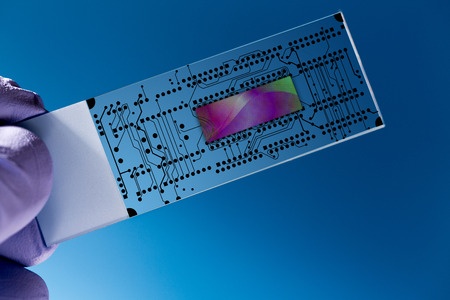Analysis of Proteine/DNA Interaction
ChIP-on-chip is a technique used to study the interaction between DNA and in vivo proteins, combining chromatin immunoprecipitation (ChIP) with microarray technology (chip). It allows to analyze, in a single experiment, a high number of DNA sequences (binding sites) to which a protein binds. Chip-on-chips are made up of DNA spots (oligonucleotides) with complementary sequences to regions of genetic promoters or the whole genome. The principle on which the ChIP-on-chip technique is based is that of the hybridization between the probes on the slide and the complementary sequences of the immunoprecipitated genomic DNA with the protein of interest.
The ChIP-on-chip allows to monitor the behavior of promoters for the study of genetic regulation mechanisms: a bridge between genomic and proteomic expression made possible by arrays that combine extended genome coverage and great sensitivity.
Microgem Lab provides the “Analysis of Protein/DNA Interaction by Immunoprecipitation” service. Analysis of the entire genome will allow you to determine the location of the binding sites. Possibility to analyze DNA extracted from tissues and cells of a wide variety of organisms and species.
Workflow of “Analysis of DNA/protein interaction by immunoprecipitation” service
- Consultancy – A free consultation will be provided for project optimization (number of samples to be analyzed, methodology, costs). During the consultation phase, advice will be provided on the sample preparation method.
- Sample Requirements –The sample to be sent consists of a formaldehyde-treated cell pellet (5×107-1×108 cells for each immunoprecipitation) for cross-link DNA proteins, frozen in liquid N2 and stored at -80 ° C.
- Lysis and Sonication - The cell pellet will be lysed and centrifuged to isolate the nuclei. DNA extracted from nuclei will be sonicated.
- Immunoprecipitation of DNA – DNA, after sonication, will be immunoprecipitated by a monoclonal antibody specific to the protein of interest linked to magnetic beads. The eluted DNA and DNA reference will be treated with enzymes for digestion of RNA and proteins and extracts by organic solvents.
- DNA Amplification - DNA fragments, to which known sequence linkers will be bound, will be amplified by PCR.
- Labeling, Hybridization and Reading of the Microarray – The immunoprecipitated DNA sample and amplified DNA reference will be labeled with Cyanine5-dUTP and Cyanine3-dUTP respectively, purified and co-hybridized on specific microarray. After washing, the microarray will be analyzed by scanner and the fluorescence image will be digitized.
- Data Analysis – Data quality control (QC) and normalization.
- Statistical Data Analysis – Prediction of binding sites. Identification and quantification of genomic probes, genes and genomic loci that have a significant link.
- Final Report – At the end of the project, a final report will be provided including the results of the various stages of project development. The results presented in the report can be discussed with the scientific team.
